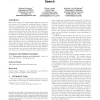73 search results - page 9 / 15 » Effective Time Ratio: A Measure for Web Search Engines with ... |
WWW
2004
ACM
14 years 7 months ago
2004
ACM
Theoretical analysis of the Web graph is often used to improve the efficiency of search engines. The PageRank algorithm, proposed by [5], is used by the Google search engine [4] t...
WSDM
2010
ACM
14 years 1 months ago
2010
ACM
Web search engines are traditionally evaluated in terms of the relevance of web pages to individual queries. However, relevance of web pages does not tell the complete picture, si...
CIKM
2008
Springer
13 years 8 months ago
2008
Springer
We introduce a unified graph representation of the Web, which includes both structural and usage information. We model this graph using a simple union of the Web's hyperlink ...
WWW
2006
ACM
14 years 7 months ago
2006
ACM
It has become a promising direction to measure similarity of Web search queries by mining the increasing amount of clickthrough data logged by Web search engines, which record the...
WWW
2006
ACM
14 years 7 months ago
2006
ACM
XML is fast becoming the standard format to store, exchange and publish over the web, and is getting embedded in applications. Two challenges in handling XML are its size (the XML...

